The Vessel
by Anna Altman
Even empty, the serene, low-slung Palestinian Museum stands as the most ambitious cultural institution ever established in the West Bank — but what will it do, and what can it do, in a place where curating requires a diplomat’s finesse?
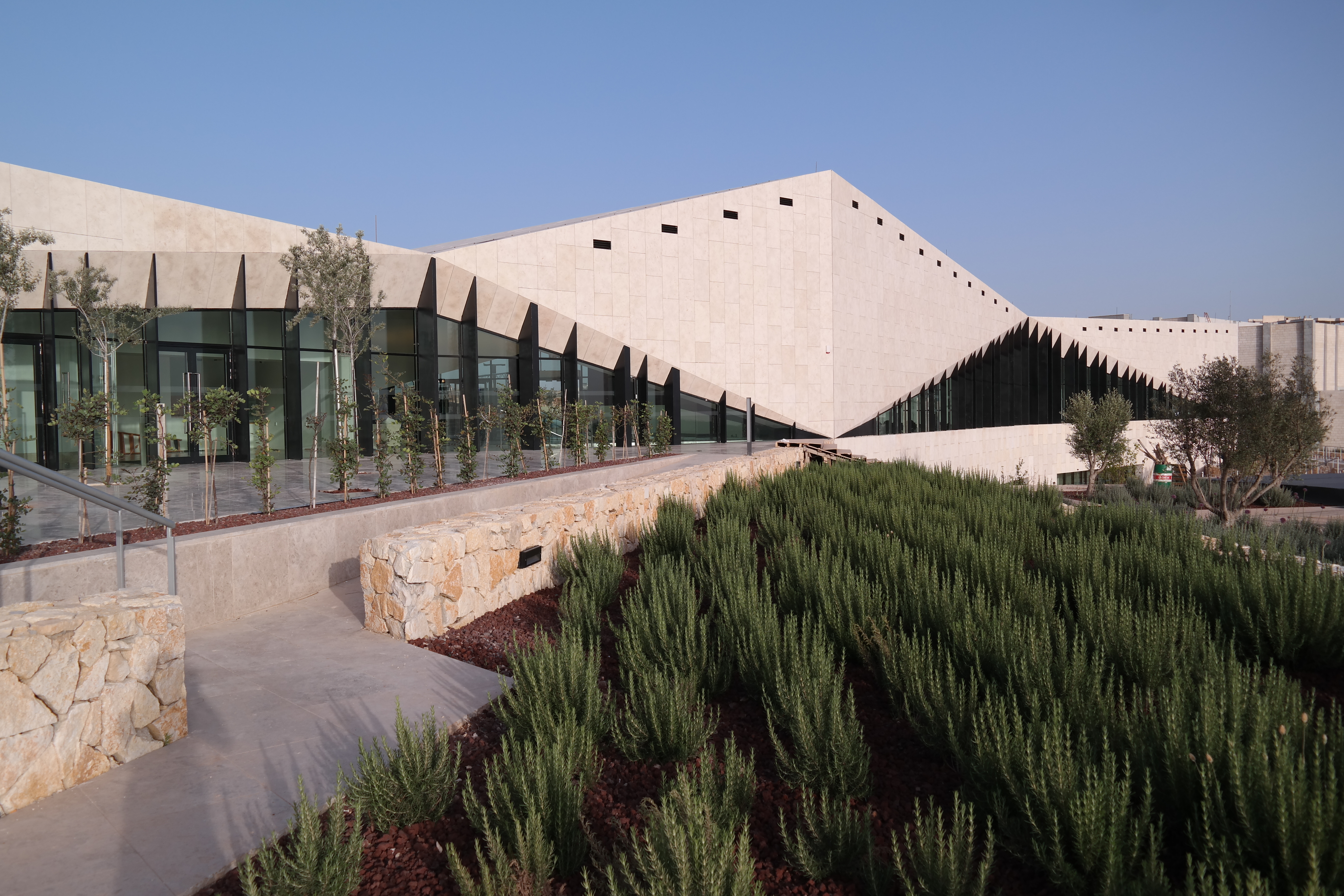
The west façade of the Palestinian Museum. 2016. Photo: Oliver Wainwright.
This essay on the Palestinian Museum in Birzeit appeared in issue no. 5 of Even, published in October 2016 — shortly after the empty museum's inauguration. In August 2017, the museum at last opens its first exhibition: “Jerusalem Lives,” a group show featuring more than three dozen artists.
I.
On a mild evening this past May, nearly 2,000 women and men milled around on a broad pavilion in a far corner of the Birzeit University campus outside Ramallah, the de facto capital of the Palestinian Authority. A dry wind rustled the branches of newly planted apricot and olive trees and blew the traces of lavender, rosemary, and chamomile across cascading tiers of terraces. The elegantly dressed crowd had gathered to celebrate the opening of the Palestinian Museum, an arts institution 20 years in development, whose national scope goes hand-in-hand with international ambitions. Palestinian president Mahmoud Abbas, who has no formal connection to the museum, spoke at the inauguration. He congratulated the founders on their achievement; he emphasized the importance of such an institution to building a state.
The building, designed by the Dublin- and Berlin-based architecture firm Heneghan Peng, is a bit less than 40,000 square feet, just about half the size of a soccer field. With a glinting façade of local limestone, the building’s prismatic shape, folded with crisp edges like a piece of origami, echoes the angular agricultural terraces that rise to meet it. Two great triangular windows face west, divided by vertical black-painted steel fins that mitigate the wind—the site is half a mile above sea level—and act as sunshades to keep the building from overheating. An amphitheater, cut into the hilltop on the western side of the building, also offers shelter from the wind. (At the inauguration, the amphitheater served as an orchestral pit, accompanying dancers inside the museum, visible through the windows and sun fins.)
The long, low building houses galleries, screening rooms, classrooms, a café and a bookshop, and the museum’s offices. Outside are over 400,000 square feet of gardens, designed by the Jordanian landscape architect Lara Zureikat and planted with local trees and plant species. The complex cost an estimated $30 million and took four years to build. In the next ten years, funds permitting, a second phase of building will more than double the usable exhibition space and introduce a library. The building’s site is on long-term loan from Birzeit University, whose main campus is within walking distance of the museum. Omar al-Qattan, the chairman of the Palestinian Museum taskforce, told me he hopes that students will visit and make themselves at home.
That evening, however, the interior of the building was empty. The galleries, classrooms, and offices all sat vacant, waiting to be used.
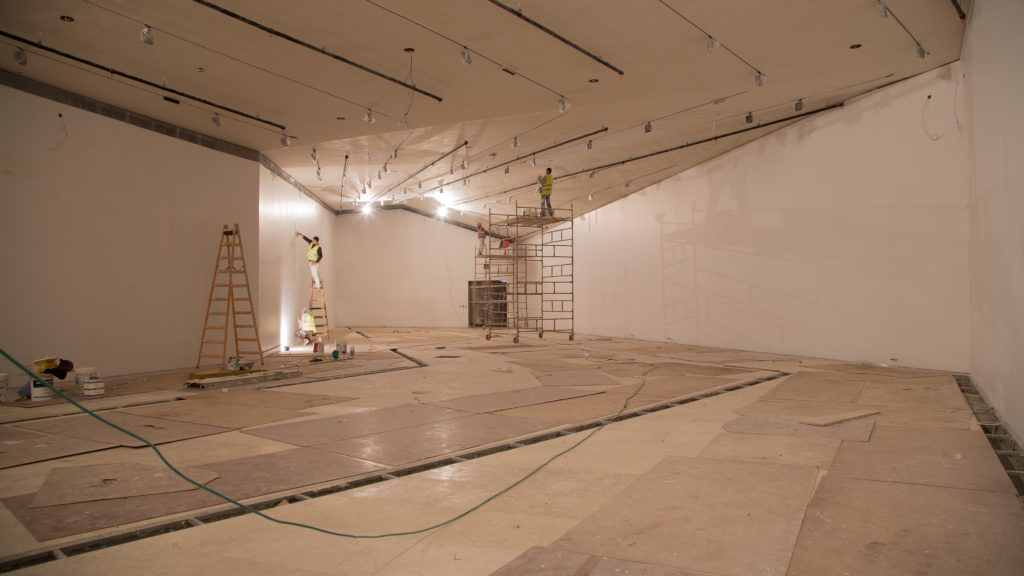
In the run-up to the event in May both Qattan and the architects were careful to define the event: this was only the inauguration of the finished building. The museum would truly open in October, with the museum’s contribution to the Qalandiya International, a regional biennial. This fact got muddled, though, thanks to an unplanned change in museum leadership. Jack Persekian, the museum’s previous director, resigned this past December amid ongoing differences with the board. An exhibition he planned, called “Never-Part,” which was to focus on the objects that exiled Palestinians hold most dear, was canceled. Shortly before the building’s inauguration, a new director was appointed: Mahmoud Hawari, an archaeologist and curator at the British Museum. Unlike Persekian, a Jerusalem-born contemporary art expert, Hawari specializes in pre-modern Islamic art. (The board says this does not indicate a shift in focus for the museum.)
Local and international press picked up the inauguration of the museum building. There, too, the scope of the event got jumbled. The museum was alternately hailed as an impressive, sustainable building, featuring innovative construction methods executed despite the difficulties of the occupation, and slighted for opening without a collection or even an inaugural show. “So where are the exhibits?” the Washington Post asked, while the New York Times bluntly stated, “Palestinian cultural and social initiatives have often failed to gain traction and find consistent leadership.” The magazine Israel Today went so far as to suggest that there were no exhibits because “there is no distinct ‘Palestinian’ history or culture.”
“If we had built this in Sweden with government subsidies,” Qattan told the Washington Post, “I would be opening a museum today with an amazing collection and a wonderful exhibit. Instead, we built a new museum in the West Bank entirely with private funds, at a time when fundraising has been especially challenging,” he said. “We built a museum despite checkpoints, walls, occupation.”
In an email to me, Qattan wrote that the press coverage was in “utter bad faith.” He went on: “The completion of such an ambitious building was a major milestone for the project and we wanted to celebrate this significant achievement, particularly in the dreadful circumstances in which Palestine is currently living. So the importance of marking this stage hopefully sent a message of hope and determination.” He was keen not to dwell in counterargument: “It is also a particularly beautiful building!”
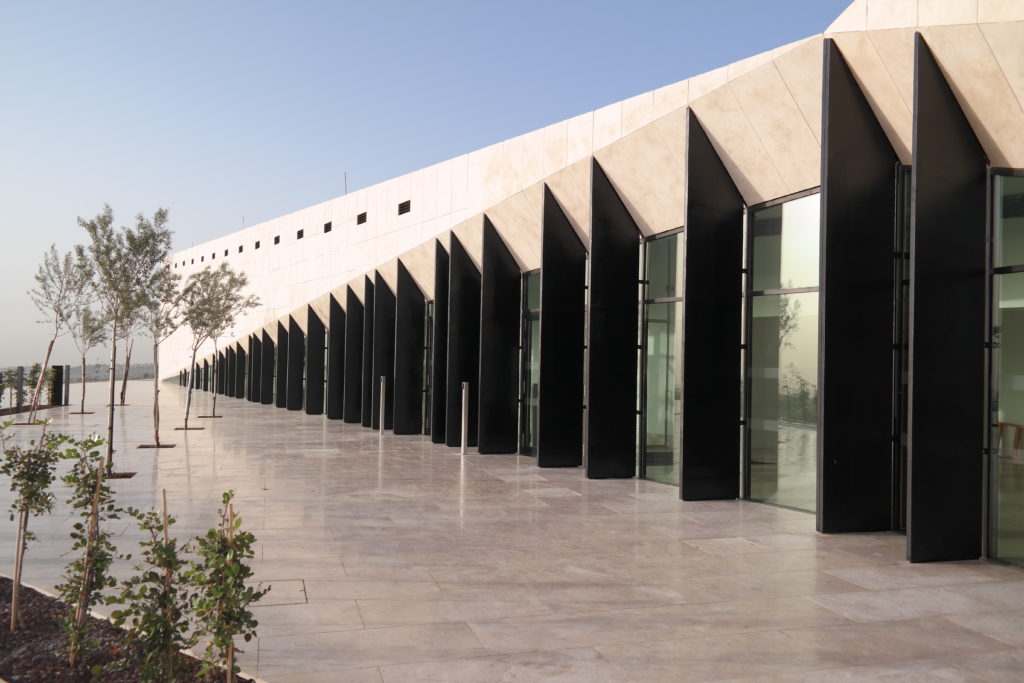
II.
What does a museum do? Traditionally it serves as a repository of artifacts or artworks. It probably stewards a permanent collection, and perhaps an archive as well; it usually presents information to educate a public, or many different publics. It may host education groups and traveling exhibitions, or allow a safe and quiet space for individual study.
Since its conception, the Palestinian Museum has sought at various points to perform all of these duties, an all-in-one arrangement that has shape-shifted over the years. Today, Qattan says that the museum will tell the history of Palestinians in the area over the past 200 years, from the Ottoman Empire through the British mandate over Palestine to today. Naturally, it will cover Israel’s foundation and the subsequent displacement of Palestinians. It will continue with the history of Palestinians abroad as well as their living conditions in the Gaza Strip, West Bank, and east Jerusalem under Jordanian and Israeli sovereignty, as well as the last 22 years of partial self-rule. But how it will tell these stories — with what objects and methods — remains an open question.
The Palestinian Museum’s existence is, like so many Palestinian institutions, in response to an absence. In 1998, the Welfare Association, a large NGO offering humanitarian, education, and cultural support to Palestinians in Israel, Lebanon, and the West Bank and Gaza, conceived of a “commemorative museum.” It was to focus on the 1948 dispossession of more than 700,000 Palestinians that took place at the founding of Israel — the Nakba, as Palestinians call it, or “the catastrophe.”
For 19 years, however, there was no building. The Welfare Association (also known as Taawon, meaning “cooperation” in Arabic) sought funds from private donors to build its memorial. Yet by 2000, during the second intifada, even the idea of new construction had become unimaginable. Progress ground to a halt. When fundraising resumed, in 2007, the mandate for the museum had changed. The developments of the past ten years demonstrated not only the need to commemorate a collective trauma, but to support and represent Palestinian culture. “We wanted to have a dynamic museum that can look at the past but also make sure that it is aware of its importance for the present and future,” says Qattan.
Many museums and arts organizations begin with a collection. For the Palestinian Museum, this wasn’t the case: “We didn’t have a collection, we’re not a national museum, and we don’t have access to east Jerusalem,” Qattan said. (The museum is financially and administratively independent of the Palestinian Authority. Legally, it cannot act in any official capacity, whether that means representing Palestine internationally or displaying any part of its national patrimony.) As the Welfare Association worked to establish a collection, he went on, “we thought we could also be a thematic museum” that would “research, examine, and develop projects around themes and issues we felt were important for Palestinian society and culture.” These projects would range from art to social history to education.
Until now, the Palestinian Museum organization has done its best to carry on without a physical home. Indeed, a central location will not change the bare fact that the Palestinian community is divided into several segments: Palestinians in the occupied territories (the West Bank, on the one hand, and Gaza, on the other); Palestinians who live in Israel proper; and Palestinians who live in exile or as refugees abroad. There are more than 12 million Palestinians worldwide, but under half live in the territories. Another 5.5 million are registered as refugees in UN-run camps. Palestinians who live in the West Bank cannot visit Gaza, and vice versa, nor can exiled Palestinians abroad return to Israel proper or the occupied territories unless they possess a second passport from a neutral country. “It’s very hard for a museum like ours, situated in a place where we are totally cut off from more than two-thirds of the population” they seek to serve, Persekian told me last fall. “We have to access places where people cannot physically reach us.”
Restricted movement is not the only hardship that curators and art historians face. Another is the lack of Palestinian sovereignty over archeological sites located in occupied territory. A coordinator at the Palestinian Department of Antiquities and Cultural Heritage estimated that 53% of the approximately 7,000 archaeological sites identified in the West Bank and Gaza are in Area C, the division of the territories entirely under Israeli control. That means that Palestinians are forbidden to conduct developments or exploration there. Palestinians are able to excavate in Area A, but practically speaking there have been no significant digs since the Oslo Accords. In addition, an estimated 1,100 archaeological sites were destroyed in the planning and construction of the wall between Israel proper and the West Bank. Meanwhile, Israeli archaeologists continue to dig in the occupied territories in contravention of international law, and last year a coalition of leftwing Israeli groups was stymied when it filed a freedom-of-information request on ongoing archeological digs. (A UNESCO convention of 1954, to which Israel is a party, mandates that no objects retrieved in an occupied area be taken by an occupying power.)
All of this poses profound difficulties to the Palestinian Museum for the obtaining of loans, partnerships, and touring exhibitions. “There is no guarantee for international institutions that cultural objects will come in and out safely,” says Qattan. Insurance companies that underwrite loans between international museums are reluctant, or more often unwilling, to cover these objects. “If I want to borrow something from the British Museum, I really need to get a guarantee from the Israeli Prime Minister’s office” that the loan will be safe, says Qattan. According to Beshara Doumani, a professor at Brown University who served as the museum’s director from 2008 to 2010, the museum “can’t play the role” of guaranteeing protection and security for artifacts and artworks, not so long as the occupation continues. Indeed, some worry that assembling collections of historical objects in one place may only make them more vulnerable to destruction or confiscation.
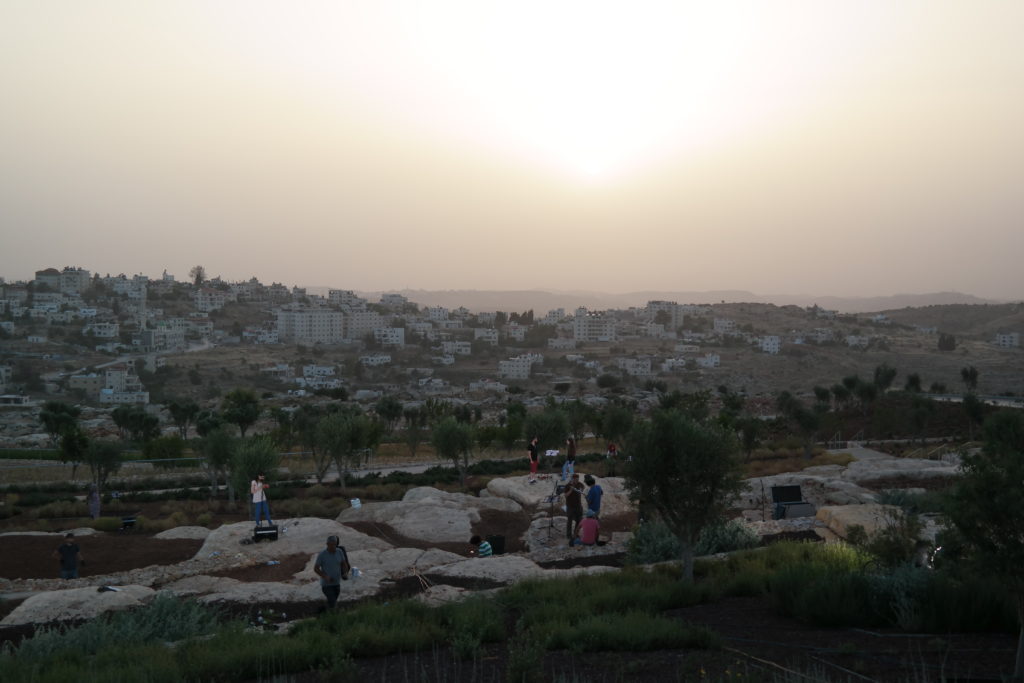
III.
The archive and the museum — these cultural institutions associated with national history, identity, and collective memory — have lately preoccupied contemporary artists, and the motivation seems especially strong where there is a need to restore histories of the marginalized or oppressed, and where narrating the past can still unsettle the present. In Palestine and elsewhere in the Middle East, the archive and the museum have lately functioned for artists as metaphors for suspicious absences, bureaucratic obstacles, and political blockades.
Two works in particular by Palestinian artists — Khalil Rabah’s Palestinian Museum of Natural History and Mankind (2003–ongoing) and Khaled Hourani’s Picasso in Palestine (2011) — demonstrate most clearly what is at stake when history and culture, and their preservation, come up against politics. Rabah’s roving, ongoing project produces the various trappings of a national museum, from newsletters to exhibitions to archival materials in different iterations for far-flung international venues. A newsletter — sometimes circulated as a PDF, other times displayed in giant painted reproductions — introduces the museum as “cubist in its impossibility; it is occupied, exiled at home, and everywhere abroad. An entirely new place, it rests nowhere while waiting for our return.” In each edition, he presents the latest news from the museum’s departments (geology, paleontology, anthropology, botany) in order to remind the viewer what kind of obstacles exist in Palestine to hinder each field. The “Earth and Solar System Department,” for example, announced its interest in 2008 in how our world is “constantly being remolded by powerful forces beyond our control.” Exhibitions feature artifacts like fossils, paintings, meteorites, and trees and plants, which Rabah describes as “irreplaceable, priceless and found almost anywhere and at all times.” An evident successor to Marcel Broodthaers’s Musée d’Art Moderne, Département des Aigles (1968–1972), in which the Belgian artist established a conceptual museum with no fixed collection or home, Rabah’s museum makes no pretense to serving as a stable repository or a place to store collective knowledge. At the same time, however, Rabah does not disavow the national museum as an institution. Instead, he reformulates its contents and strategies time and again to discover where authentic opportunity might exist.

Museum of Natural History and Mankind. 2003–ongoing. Exhibition view, Kunsthaus Hamburg, 2015. Photo: Hayo Heye.
The project Picasso in Palestine (2009–2011) was a similarly sideways investigation of the difficulties of institution building in the occupied territories. The project began when Khaled Hourani, the artistic director of the International Academy of Art Palestine in Ramallah, attempted to borrow a painting by Picasso from the Van Abbemuseum in Eindhoven, the Netherlands, and to display it in his school. Getting Picasso’s Buste de femme (1943), a sea-green portrait of a woman, to and from Ramallah was not merely a question of transport. There were also climate control and conservation concerns to consider. There was the matter of obtaining insurance in an active war zone. There were the legal intricacies of a contract executed in a state with limited international recognition. All of this necessitated bureaucratic wrangling of epic proportions, including obtaining permission from Israeli officials — that precious dispensation from the prime minister that Qattan mentioned — to ship the work without unsealing it at the crossing between Israel and the West Bank. The project was, essentially, a bureaucratic performance. Loaning the painting to the Israel Museum, 12 miles away in Jerusalem, would have been a totally different exercise.
It wasn’t always clear whether Hourani’s efforts would pay off, and the exhibition of the painting was repeatedly postponed from October 2010 until June the next year. On June 26, 2011, the painting went on public display in Ramallah, monitored at all times by two armed guards. It was visited by students as well as flocks of local residents. A parallel exhibition at the Al-Ma’mal Foundation in Jerusalem displayed the reams of correspondence required to display Picasso’s work a dozen miles away.
Looking back at how the loan came together, Hourani called the success of Picasso in Palestine “a series of orchestrated small miracles.” One of the best results of the project, he notes, was that it established the institutional relationships and international framework that might, one day, lead to another loan or collaboration. Charles Esche, the Van Abbemuseum’s director, agrees: “Together we began to speak of the idea of a dispersed museum, one that was present in the relations forged across cultural regions rather than in the art objects held in the collection.” This evocation of networks and relationships echoes the Palestinian Museum’s own emphasis on these subjects.
For Rabah and Hourani, institution building is a pragmatic, concrete task as well as a conceptual one. Between the two of them they have founded and run at least four functioning organizations. In spite of their understanding of the obstacles, they both seem to agree that such institutions and acts are essential to imagining a fully formed country in the future. “A museum is like an airport or hospital,” Hourani told the Associated Press in 2013. “It is one of the things that is part of a state.”
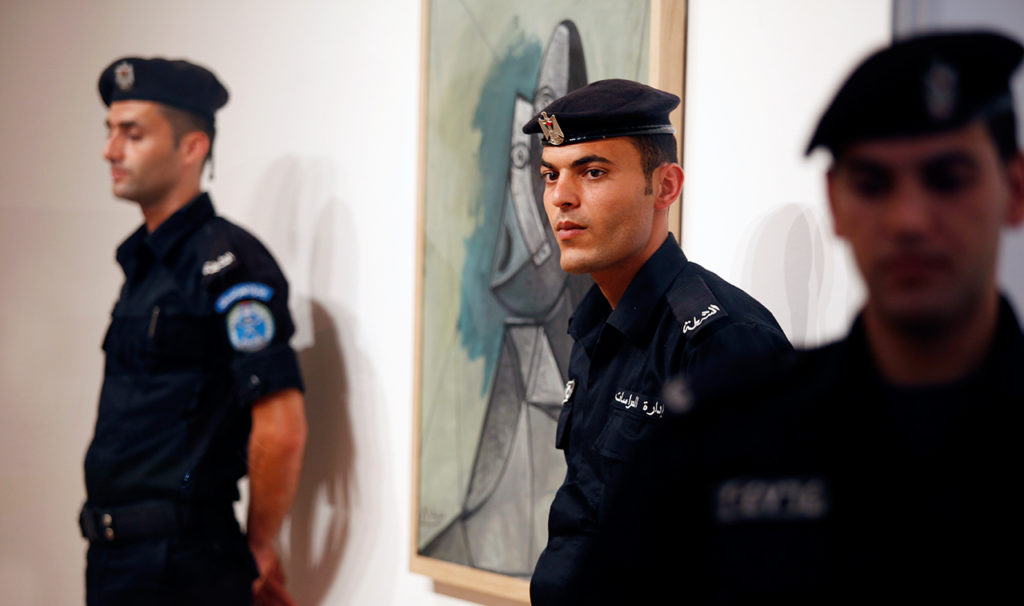
IV.
In July 2015, the Palestinian Museum sent a newsletter detailing every library that exists in Palestinian territory. The account is exhaustive, even clerical. The newsletter detailed each library’s collection (size, lending capacity, languages), its workers (trained and/or paid employees, volunteer staff), and its facilities (state of disrepair, presence of a card catalogue, computers available for community use).
The composite picture was, to an outsider reading the newsletter in a secure country, bleak. Although there are 108 libraries in Palestine, most of them can barely manage to lend books. Seven of Gaza’s 41 libraries have been damaged or destroyed in military actions. In Khan Yunis, a city in southern Gaza, workers from a municipal office, which was damaged in a 2008 bombing, moved into a local library, effectively closing it. A library in the old city of Acre doesn’t have funding to continue providing services to the researchers and academics that use it. Another, in Gaza, has been repurposed as a prison.
What’s arresting about the Palestinian Museum’s libraries inventory is how direct it is. Unlike Rabah’s museum, this is not a conceptual exercise. It is an earnest attempt to canvass the cultural resources available in a territory where information is notoriously hard to obtain — and the second step in a process of itemizing Palestine’s cultural resources. (The first step was a newsletter about the territories’ 56 museums.) Because of Israel’s prohibition on commerce with “enemy states,” Palestinians in the territories and within Israel cannot import literature from Lebanon or Syria, for example. Books and periodicals in Arabic must pass through many hands to land in Palestine; this makes the cost prohibitively high. To make matters worse, none of the Palestinian universities have library science programs, and those in Israel must be completed in Hebrew. Very few librarians are even trained.
History plays a part, too. During the 1948 expulsion, some 70,000 books were taken from homes, private collections, and institutional libraries. These volumes are still dispersed among Israeli archives and institutions and are poorly preserved. Some of these are deemed harmful to the state and are inaccessible to anyone. Approximately 6,000, housed at the Jewish National and University Library at Hebrew University, are designated as abandoned property, with no further information about their provenance.
At the most recent edition of Documenta, in 2012, the Palestinian artist Emily Jacir exhibited Ex Libris, a “library” of these displaced volumes. Over a period of two years, Jacir went to the Jerusalem library and took photographs with her mobile phone of the “abandoned property.” In Kassel, she showed these photos on shallow display shelves, the sort a library might use for magazines or periodicals. They depict stamps from the Government of Palestine Press Bureau, personal notes or dried flowers tucked between the pages of books, the ragged scrawl of a child learning to write her name. Other photographs document handwritten inscriptions, which Jacir printed in Arabic, English, and German on billboards throughout Kassel: “To a dear friend and great research historian Omar Effendi il Barghouti. A gift of respect and appreciation from the author Aref il Aref.” The collection of Ex Libris was only a facsimile of a potential library. But Jacir suggested what could, with research funds and political will, exist in a future Palestine.
150 miles north of Jerusalem, three days after the inauguration of the Palestinian Museum building, another opening took place in Beirut. A thousand people gathered to celebrate the opening of the exhibition “At the Seams: A Political History of Palestinian Embroidery” at a brand-new art space called Dar El-Nimer, an independent nonprofit dedicated to culture from Palestine and the Levant. The exhibition, whose opening drew not only Lebanese high society but also visitors from refugee camps, was billed as the “first satellite show” of the Palestinian Museum. It offers the clearest example of what the Palestinian Museum means when it says it plans to partner with other organizations. According to Rasha Salah, Dar El-Nimer’s executive director, the Lebanese institution’s role was to act as “a hosting space” that provides support, equipment, and human resources to the Palestinian Museum in absentia.
The exhibition itself concentrated on the political and sociological dimensions of embroidered textiles and clothing, and offered a window into the type of programming the Palestinian Museum might pursue. It included a number of rarely shown “intifada dresses,” designed to include Palestinian colors and flags, that were worn to weekly protests in the late 80s and early 90s to circumvent confiscation of such materials by Israeli forces. Other articles, worn in refugee camps, showcase embroidery as a sort of humble patching to repair damage from washing, cooking, and breastfeeding. Such pieces were “rarely considered worthy of study,” explains Rachel Dedman, the show’s curator, but she posits they are “equally articulate in telling you something about the conditions of who made them, the political exigencies at the time.” Dedman’s hope was to “animate this material to bring out human stories that connect to a bigger picture of Palestinian history.”
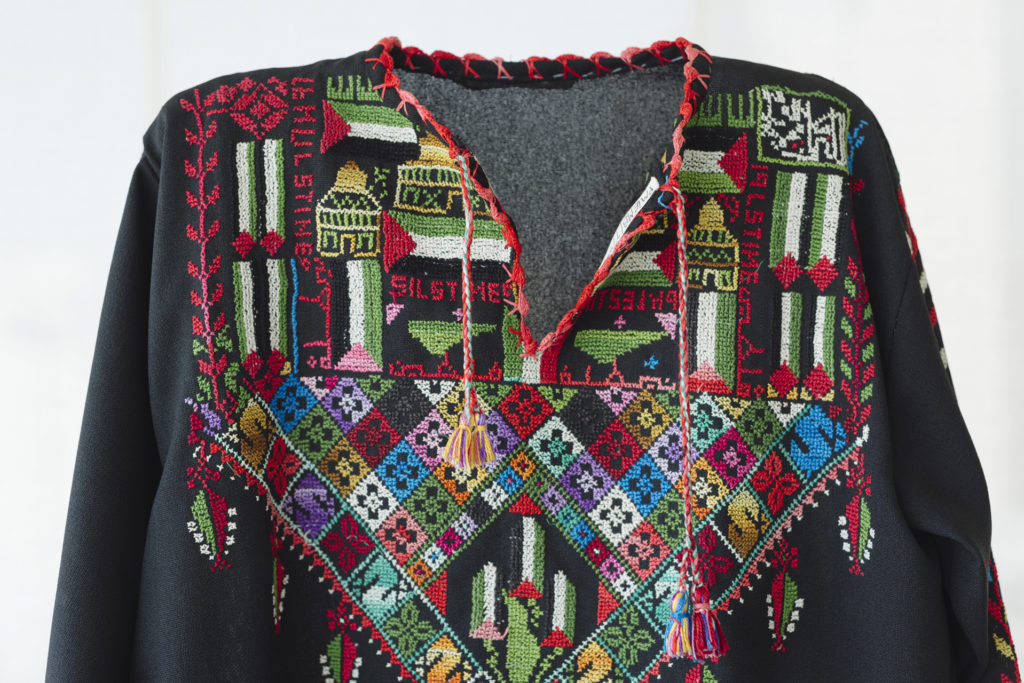
“At the Seams” also makes manifest many of the practical obstacles that hinder an institution like the Palestinian Museum or Dar El-Nimer. Because it is held in Lebanon with objects from two private Jordanian collections, the exhibition cannot be reassembled at the Palestinian Museum in Birzeit. “The risk is too high that objects will be confiscated,” explains Dedman. Even to gather objects in Beirut was a significant challenge: Dedman described at length the contortions of various staff members, who liaised with contacts and private donors to retrieve objects abroad and occasionally transported them in personal luggage across borders. (Dedman herself is British, and benefits from greater freedom of movement than collaborators or staff without a second passport.) “At the Seams” may travel to other spaces internationally, but if and when it is staged in Birzeit, it will be another incarnation altogether, drawn from local collections, supplemented with facsimiles, and potentially forgoing authentic artifacts entirely.
Even so, when I asked Salah about the details of the collaboration between the Palestinian Museum and Dar El-Nimer, she was breezy. “For me it is a very normal and practical reaction to the fact that Palestine is occupied,” she said about the idea of working in a collaborative network. “The Palestinian Museum is located in a place that at least 80% of Palestinians cannot reach. What’s a better solution than to have an exhibition every time in a different space and country?”
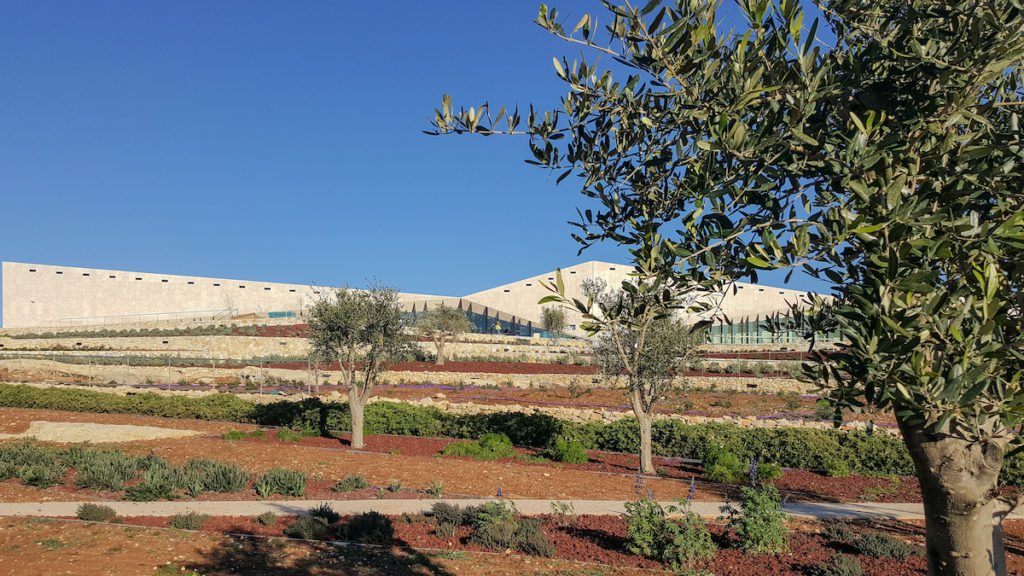
Photo: Khaled Fanni.
V.
As it seeks an audience, the Palestinian Museum wrestles with the relative value of virtual and physical space, and how these might offer access to different populations. There will be a collection, but nobody can say how big a role it will play nor how it might be used. “We will be very focused and strategic about our collecting, as we do not see ourselves as a repository, but would like to own or borrow only objects that serve our research and exhibition programs,” says Qattan. And when the institution describes itself in promotional materials, it frequently invokes interactive timelines and open-access digital platforms, as well as partnerships with Palestinian communities in Lebanon, Canada, the United States, and Chile.
Since I first spoke to representatives from the museum a year ago, there have been several projects underway. Staff members are soliciting contributions to an online archive of family and personal photographs. The museum is developing an interactive timeline with the Institute for Palestine Studies, a Beirut-based research institute founded in 1963, and the design studio Visualizing Palestine, that will be accessible online. The museum has also worked to digitize photographs taken over decades by the United Nations Relief and Works Agency for Palestine Refugees in the Near East (UNRWA). They have been documenting the camps since 1948, including schools, workshops, factories, ordinary people, cafés. But the UNRWA imposes its own access restrictions, and its agreement with the museum stipulates that the images cannot go online; they are only available for researchers who want to view the archive on site.
The Palestinian Museum, as well as other institutions in Palestine, are becoming increasingly adept at sharing materials and resources, whether online or in person. Many of the most enduring and successful artistic and cultural ventures in or around Palestine adopt a methodology of multiple venues in diverse locations. Rabah’s ArtSchool Palestine and the Riwaq Biennale showed works in Palestine, London, Lebanon, and elsewhere. In fall 2014, the Palestinian Museum helped organize the Qalandiya International, which included several exhibitions about how museums and archives shape — or distort — national identity. Those particular segments of Qalandiya were on display in a West Bank cultural center that also serves as a library. In turn, this fall’s Qalandiya International will use not only the Palestinian Museum as one of its venues, but Dar El-Nimer as well.

VI.
The last decade in this region saw significant restrictions on the movement of people and objects, and both the Palestinian Museum of Natural History and Humankind and Picasso in Palestine are works of their time. They are embedded in the context of the years after the second intifada, and they served an essential purpose. But in 2016 the situation looks different. The peace process seems hopelessly frozen, and yet collaboration among dynamic cultural institutions across borders — hoped for in Picasso in Palestine, demanded by the Palestinian Museum — are now taken as matter-of-fact and are on their way to becoming routine.
The fact of a museum on the ground won’t solve everything. The facile suggestion that an empty museum denotes a null culture, or one that is pathologically disorganized, demonstrates how deep suspicions lie. But the Palestinian Museum is not interested in justifying its existence on political grounds. It looks beyond that very limited horizon to questions about historical Palestine’s culture and the role of the museum in a state with limited resources.
Inauguration of an empty building doesn’t portend failure. Like the museum’s unsparing account of the territories’ libraries, it is an honest admission of the obstacles that exist. Milestones more easily achieved elsewhere will take longer and require more resources in Palestine. That isn’t a reason to withhold celebration. Incremental progress is progress still. Amid dwindling confidence for a two-state solution, the private and international support to exhibit and protect Palestinian culture is growing. Fundraising for a flagship cultural institution that was impossible in 2000 has now been achieved.
When this magazine went to press [in August of 2016], the museum had just announced its participation in this October’s Qalandiya International; it hopes to announce its program for 2017-2018 then. A proper exhibition, curated by and installed at the museum, may therefore be a year or more off. But at the building inauguration, Mahmoud Abbas called the Palestinian Museum building “an act inspired by hope for a better future.” It may not be able to fill all the roles of a museum, not this October, maybe not even next year. But there is now another space in Palestine, state-of-the-art and even beautiful, to look and listen, to read, and to learn. That is hope worth hanging on to.